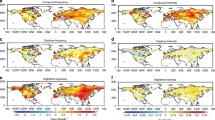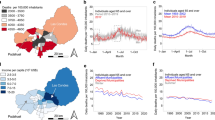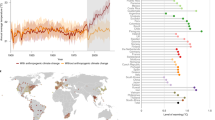Abstract
Urban areas are experiencing strongly increasing hot temperature extremes. However, these urban heat events have seldom been the focus of traditional detection and attribution analysis designed for regional to global changes. Here we show that compound (day–night sustained) hot extremes are more dangerous than solely daytime or nighttime heat, especially to female and older urban residents. Urban compound hot extremes across eastern China have increased by 1.76 days per decade from 1961 to 2014 with fingerprints of urban expansion and anthropogenic emissions detected by a stepwise detection and attribution method. Their attributable fractions are estimated as 0.51 (urbanization), 1.63 (greenhouse gases) and −0.54 (other anthropogenic forcings) days per decade. Future emissions and urbanization would make these compound events two to five times more frequent (2090s versus 2010s), leading to a threefold-to-sixfold growth in urban population exposure. Our findings call for tailored adaptation planning against rapidly growing health threats from compound heat in cities.
This is a preview of subscription content, access via your institution
Access options
Access Nature and 54 other Nature Portfolio journals
Get Nature+, our best-value online-access subscription
$29.99 / 30 days
cancel any time
Subscribe to this journal
Receive 12 print issues and online access
$209.00 per year
only $17.42 per issue
Buy this article
- Purchase on Springer Link
- Instant access to full article PDF
Prices may be subject to local taxes which are calculated during checkout




Similar content being viewed by others
Data availability
All the data that support the findings are publicly available. The temperature observations and LULC maps are available at http://data.cma.cn/en/ and https://www.resdc.cn/Datalist1.aspx?FieldTyepID=1,3 (website available only in Chinese), respectively. The CMIP5 and CMIP6 model outputs can be accessed at https://esgf-node.llnl.gov/projects/cmip5/ and https://esgf-node.llnl.gov/projects/cmip6/, respectively. The global projections of future population and urban expansion based on the SSPs are available at https://sedac.ciesin.columbia.edu/data/set/popdynamics-1-8th-pop-base-year-projection-ssp-2000-2100-rev01 and https://doi.pangaea.de/10.1594/PANGAEA.905890, respectively. The mortality data can be secured through a government data-sharing portal (https://www.phsciencedata.cn/Share/en/index.jsp), from the provincial mortality-surveillance system on registration or from the corresponding author W.M.
Code availability
All the codes associated with this paper are available from the corresponding authors upon reasonable request.
References
McMichael, A. J., Woodruff, R. E. & Hales, S. Climate change and human health: present and future risks. Lancet 367, 859–869 (2006).
Petkova, E. P., Morita, H. & Kinney, P. L. Health impacts of heat in a changing climate: how can emerging science inform urban adaptation planning? Curr. Epidemiol. Rep. 1, 67–74 (2014).
Wang, D. et al. The impact of extremely hot weather events on all-cause mortality in a highly urbanized and densely populated subtropical city: a 10-year time-series study (2006–2015). Sci. Total Environ. 690, 923–931 (2019).
Karl, T. R. & Knight, R. W. The 1995 Chicago heat wave: how likely is a recurrence? Bull. Am. Meteorol. Soc. 78, 1107–1120 (1997).
Kovats, R. S. & Hajat, S. Heat stress and public health: a critical review. Annu. Rev. Public Health 29, 41–55 (2008).
Duren, R. M. & Miller, C. E. Measuring the carbon emissions of megacities. Nat. Clim. Change 2, 560–562 (2012).
Gu, C., Guan, W. & Liu, H. Chinese urbanization 2050: SD modeling and process simulation. Sci. China Earth Sci. 60, 1067–1082 (2017).
Chen, Y. & Zhai, P. Revisiting summertime hot extremes in China during 1961–2015: overlooked compound extremes and significant changes. Geophys. Res. Lett. 44, 5096–5103 (2017).
Liao, W. et al. Amplified increases of compound hot extremes over urban land in China. Geophys. Res. Lett. 48, e2020GL091252 (2021).
Yang, J. et al. Projecting heat-related excess mortality under climate change scenarios in China. Nat. Commun. 12, 1039 (2021).
Stott, P. A. et al. Detection and attribution of climate change: a regional perspective. Wiley Interdiscip. Rev. Clim. Change 1, 192–211 (2010).
Wang, J. et al. Impact of urbanization on changes in temperature extremes in Beijing during 1978–2008. Chin. Sci. Bull. 58, 4679–4686 (2013).
Han, W. et al. The mechanisms and seasonal differences of the impact of aerosols on daytime surface urban heat island effect. Atmos. Chem. Phys. 20, 6479–6493 (2020).
Kong, D. et al. Contributions of global warming and urbanization to the intensification of human-perceived heatwaves over China. J. Geophys. Res. Atmos. 125, e2019JD032175 (2020).
Sun, Y. et al. Contribution of urbanization to warming in China. Nat. Clim. Change 6, 706–709 (2016).
Yan, Z. et al. Re-assessing climatic warming in China since 1900. J. Meteor. Res. 34, 243–251 (2020).
Mazdiyasni, O. et al. Increasing probability of mortality during Indian heat waves. Sci. Adv. 3, e1700066 (2017).
Baccini, M. et al. Heat effects on mortality in 15 European cities. Epidemiology 19, 711–719 (2008).
Murage, P., Hajat, S. & Kovats, R. S. Effect of night-time temperatures on cause and age-specific mortality in London. Environ. Epidemiol. 1, e005 (2017).
Thomas, N. P. et al. Mechanisms associated with daytime and nighttime heat waves over the contiguous United States. J. Appl. Meteorol. Climatol. 59, 1865–1882 (2020).
Xue, W. et al. Declining diurnal temperature range in the North China Plain related to environmental changes. Clim. Dyn. 52, 6109–6119 (2019).
Wu, L., Feng, J. & Miao, W. Simulating the impacts of irrigation and dynamic vegetation over the North China Plain on regional climate. J. Geophys. Res. Atmos. 123, 8017–8034 (2018).
Schneider, A. & Mertes, C. M. Expansion and growth in Chinese cities, 1978–2010. Environ. Res. Lett. 9, 024008 (2014).
Graham, M. H. Confronting multicollinearity in ecological multiple regression. Ecology 84, 2809–2815 (2003).
Chen, G. et al. Global projections of future urban land expansion under shared socioeconomic pathways. Nat. Commun. 11, 537 (2020).
Taylor, K. E., Stouffer, R. J. & Meehl, G. A. An overview of CMIP5 and the experiment design. Bull. Am. Meteorol. Soc. 93, 485–498 (2012).
Marquaridt, D. W. Generalized inverses, ridge regression, biased linear estimation, and nonlinear estimation. Technometrics 12, 591–612 (1970).
Vittinghoff, E. et al. Regression Methods in Biostatistics: Linear, Logistic, Survival, and Repeated Measures Models (Springer, 2012).
Li, D. et al. Urban heat island: aerodynamics or imperviousness? Sci. Adv. 5, eaau4299 (2019).
Wang, Z. et al. Incorrect Asian aerosols affecting the attribution and projection of regional climate change in CMIP6 models. NPJ Clim. Atmos. Sci. 4, 2 (2021).
Li, D. & Bou-Zeid, E. Synergistic interactions between urban heat islands and heat waves: the impact in cities is larger than the sum of its parts. J. Appl. Meteorol. Climatol. 52, 2051–2064 (2013).
Miralles, D. G., Teuling, A. J., van Heerwaarden, C. C. & de Arellano, J. V. Mega-heatwave temperatures due to combined soil desiccation and atmospheric heat accumulation. Nat. Geosci. 7, 345–349 (2014).
Horton, D. E. et al. Contribution of changes in atmospheric circulation patterns to extreme temperature trends. Nature 522, 465–469 (2015).
Shepherd, T. G. Atmospheric circulation as a source of uncertainty in climate change projections. Nat. Geosci. 7, 703–708 (2014).
Davis, R. E., Hondula, D. M. & Patel, A. P. Temperature observation time and type influence estimates of heat-related mortality in seven U.S. cities. Environ. Health Perspect. 124, 795–804 (2016).
Nicholls, N., Skinner, C., Loughnan, M. & Tapper, N. A simple heat alert system for Melbourne, Australia. Int. J. Biometeorol. 52, 375–384 (2008).
Xu, W. et al. Homogenization of Chinese daily surface air temperatures and analysis of trends in the extreme temperature indices. J. Geophys. Res. Atmos. 118, 9708–9720 (2013).
Wang, X. L. & Feng, Y. RHtestsV3 User Manual (Environment Canada, 2010); http://etccdi.pacificclimate.org/RHtest/RHtestsV3_UserManual.doc
Liu, J. et al. Spatiotemporal characteristics, patterns, and causes of land-use changes in China since the late 1980s. J. Geogr. Sci. 24, 195–210 (2014).
Liu, J. et al. Spatial patterns and driving forces of land use change in China during the early 21st century. J. Geogr. Sci. 20, 483–494 (2010).
Eyring, V. et al. Overview of the Coupled Model Intercomparison Project Phase 6 (CMIP6) experimental design and organization. Geosci. Model Dev. 9, 1937–1958 (2016).
Liu, T. et al. Ambient temperature and years of life lost: a national study in China. Innovation 2, 100072 (2021).
Jones, B. & O’Neill, B. C. Spatially explicit global population scenarios consistent with the Shared Socioeconomic Pathways. Environ. Res. Lett. 11, 084003 (2016).
Gasparrini, A., Armstrong, B. & Kenward, M. G. Distributed lag non-linear models. Stat. Med. 29, 2224–2234 (2010).
Ye, X. et al. Ambient temperature and morbidity: a review of epidemiological evidence. Environ. Health Perspect. 120, 19–28 (2012).
Gasparrini, A. & Armstrong, B. Reducing and meta-analysing estimates from distributed lag non-linear models. BMC Med. Res. Methodol. 13, 1 (2013).
Liao, W. et al. Stronger contributions of urbanization to heat wave trends in wet climates. Geophys. Res. Lett. 45, 11310–11317 (2018).
Chen, M., Liu, W. & Tao, X. Evolution and assessment on China’s urbanization 1960–2010: under-urbanization or over-urbanization? Habitat Int. 38, 25–33 (2013).
Allen, M. R. & Stott, P. A. Estimating signal amplitudes in optimal fingerprinting, part I: theory. Clim. Dyn. 21, 477–491 (2003).
Ribes, A., Planton, S. & Terray, L. Application of regularised optimal fingerprinting to attribution. Part I: method, properties and idealised analysis. Clim. Dyn. 41, 2817–2836 (2013).
Liu, X. et al. Simulating urban dynamics in China using a gradient cellular automata model based on S-shaped curve evolution characteristics. Int. J. Geogr. Inf. Sci. 32, 73–101 (2017).
Yuan, F. & Bauer, M. E. Comparison of impervious surface area and normalized difference vegetation index as indicators of surface urban heat island effects in Landsat imagery. Remote Sens. Environ. 106, 375–386 (2007).
Zhou, D. et al. Spatiotemporal trends of urban heat island effect along the urban development intensity gradient in China. Sci. Total Environ. 544, 617–626 (2016).
Wang, J., Tett, S. F. B. & Yan, Z. Correcting urban bias in large-scale temperature records in China, 1980–2009. Geophys. Res. Lett. 44, 401–408 (2017).
An, N. et al. An observational case study of synergies between an intense heat wave and the urban heat island in Beijing. J. Appl. Meteorol. Climatol. 59, 605–620 (2020).
Sen, P. K. Estimates of the regression coefficient based on Kendall’s tau. J. Am. Stat. Assoc. 63, 1379–1389 (1968).
Kendall, M. G. Rank Correlation Methods (Griffin, 1975).
Hollander, M. & Wolfe, D. Nonparametric Statistical Methods Ch. 9 (John Wiley & Sons, 1973).
Acknowledgements
We thank the National Meteorological Information Centre of the China Meteorological Administration for compiling the observational climatic data and we appreciate the Data Center for Resources and Environmental Sciences of the Chinese Academy of Sciences for developing the temporally evolving LULC maps. We acknowledge the World Climate Research Programme’s Working Group on Coupled Modelling, which coordinated and promoted CMIP5 and CMIP6, and we thank the climate modelling groups for producing and making available their model outputs. We thank B. Jones and B. C. O’Neill for developing the spatially explicit global population projections. We also thank G. Chen, X. Li and X. Liu for sharing the global projections of future urban land expansion. J.W., Y.C., Z.Y. and P.Z. were supported jointly by the National Key Research and Development Programme of China (Grant No. 2018YFC1507700) and the Strategic Priority Research Program of the Chinese Academy of Sciences (Grant No. XDA20020201). G.H., W.M. and C.H. were jointly supported by the National Nature Science Foundation of China (Grant No. 42075173) and National Key Research and Development Programme of China (Grant No. 2018YFA0606200). S.F.B.T. was funded by the UK-China Research and Innovation Partnership Fund through the Met Office of Climate Science for Service Partnership China as part of the Newton Fund.
Author information
Authors and Affiliations
Contributions
Y.C., J.W., G.H., S.F.B.T. and W.M. designed the research; J.W., W.L., G.H. and Y.C. performed the analyses; J.W. wrote the draft, and Y.C., J.W. and S.F.B.T. reviewed and edited it; S.F.B.T., Z.Y., P.Z., J.F., W.M., C.H. and Y.H. gave valuable suggestions on the analyses; all authors contributed to the interpretation of the results.
Corresponding authors
Ethics declarations
Competing interests
The authors declare no competing interests.
Additional information
Peer review information Nature Climate Change thanks Prathap Ramamurthy, Ting Sun and Robbie Parks for their contribution to the peer review of this work.
Publisher’s note Springer Nature remains neutral with regard to jurisdictional claims in published maps and institutional affiliations.
Supplementary information
Supplementary Information
Supplementary Note 1, Discussions 1–3, Figs. 1–14 and Tables 1–5.
Rights and permissions
About this article
Cite this article
Wang, J., Chen, Y., Liao, W. et al. Anthropogenic emissions and urbanization increase risk of compound hot extremes in cities. Nat. Clim. Chang. 11, 1084–1089 (2021). https://doi.org/10.1038/s41558-021-01196-2
Received:
Accepted:
Published:
Issue Date:
DOI: https://doi.org/10.1038/s41558-021-01196-2
This article is cited by
-
The evolution of social-ecological system interactions and their impact on the urban thermal environment
npj Urban Sustainability (2024)
-
Effects of the urban landscape on heatwave-mortality associations in Hong Kong: comparison of different heatwave definitions
Frontiers of Environmental Science & Engineering (2024)
-
Research progresses and prospects of multi-sphere compound extremes from the Earth System perspective
Science China Earth Sciences (2024)
-
Identification and characterization of global compound heat wave: comparison from four datasets of ERA5, Berkeley Earth, CHIRTS and CPC
Climate Dynamics (2024)
-
Carbon footprint of higher education institutions
Environment, Development and Sustainability (2024)



